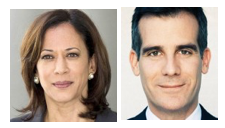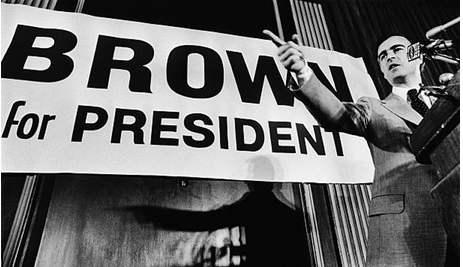CommentsCAL BUZZ--We’ve barely recovered from the 2018 mid-terms, but the air is already thick with speculation about whether a candidate from California will enter the 2020 race for president. And some potential candidates are making moves that encourage that speculation.
Freshman U.S. Sen. Kamala Harris is writing a book and crisscrossed the country on behalf of Democratic candidates. Los Angeles Mayor Eric Garcetti has traveled to Iowa and other states. Rep. Eric Swalwell, one of the Democrats’ public faces in the Russia probe, is toying with a run, and billionaire Tom Steyer is a regular mentionable.
 It makes sense to figure that someone from the Golden State will run for president. Bigger than Canada or Australia, California offers 55 electoral votes – one-fifth of the 270 needed to win the Electoral College. The state’s 2020 primary has been moved up to March, and California sends a behemoth delegation to the Democratic National Convention. And two presidents have been elected from the state, Richard Nixon in 1968 and Ronald Reagan in 1980 (both Republicans, interestingly).
It makes sense to figure that someone from the Golden State will run for president. Bigger than Canada or Australia, California offers 55 electoral votes – one-fifth of the 270 needed to win the Electoral College. The state’s 2020 primary has been moved up to March, and California sends a behemoth delegation to the Democratic National Convention. And two presidents have been elected from the state, Richard Nixon in 1968 and Ronald Reagan in 1980 (both Republicans, interestingly).
Tilting at Windmills Nevertheless, recent history offers some cautionary tales. Over the past 40 years, most California presidential candidates have lost – and for three of the most notable, their failures affected their standing in the state and their political futures.
Consider Gov. Jerry Brown, who, during his first iteration as governor, twice ran for president. In 1976, less than two years into his first term and just 38, Brown sought the Democratic nomination for president and won a handful of states, but ended up with only 300 delegates, behind both Georgia Gov. Jimmy Carter and Arizona Rep. Morris Udall.
Californians indulged Linda Ronstadt’s boyfriend his fling in 1976, but they turned on him in 1980, when he challenged a sitting Democratic president. Against Carter, Brown won only 10 percent of the vote in the New Hampshire primary. Californians didn’t like Brown’s inattention to their critical issues and in the state’s Democratic primary gave the sitting governor a meager 4 percent of the vote.
Two years later Brown faced retribution from California voters when he ran for the U.S. Senate. Although he had won his 1978 re-election by 20 percent, Brown lost the Senate election to San Diego Mayor Pete Wilson, whose only previous statewide outing had been finishing fourth in the 1978 GOP primary for governor. To boot, the Democrats lost the governorship to Republican Attorney Gen. George Deukmejian.
Cranston’s Folly California U.S. Sen. Alan Cranston was the first to launch a bid for president in 1984. Although respected in the Senate, Cranston at 69 was a gaunt figure with orangish hair. He won some straw polls based on his fervent advocacy of a nuclear freeze, but finished a weak fourth in the Iowa caucuses and dropped out after drawing just 2 percent of the vote in New Hampshire.
Cranston had first been elected to the Senate in 1968 and had won re-election by hefty margins in 1974 and ’80, but his dalliance with the presidency left him mired in campaign debt and his quixotic bid was not viewed positively at home. Partially as a result, he barely won his seat again in 1986 against moderate GOP Rep. Ed Zschau of Silicon Valley. Six years later, Cranston retired.
Jerry Brown refashioned himself as a 1-800 populist for president in 1992. In a large field including the ultimate nominee, Bill Clinton, Brown did manage to last until the national convention where he spoke. But in the California Democratic primary that year, Clinton handily beat Brown 47-40 percent. It would be another 14 years until he ran statewide again, for Attorney General in 2006.
The Wilson Debacle Republican Gov. Pete Wilson, who rode an anti-immigrant proposition to a re-election victory in 1994 promised voters he would serve out his full term. Instead, he decided to run for president. Wilson, who had been a moderate, pro-choice Republican, lurched to the right on issues like immigration and affirmative action, seeking to burnish his bona fides with conservative GOP primary voters across the country.
It didn’t matter. His campaign was plagued with missteps and misfortunes. Conservative primary voters in other states still viewed Wilson as governor of “La La Land.” And Republicans back home were unhappy that his out-of-state travel left Democratic Lt. Gov. Gray Davis as acting governor. Wilson dropped out of the race in September of ’95, before a single vote had been cast.
Despite his huge re-election win just the year before, Wilson’s popularity never recovered – a Los Angeles Times poll in ‘95 showed that only 30 percent of California Republican voters thought he should have run for president. He drove Latinos away from the GOP. And his absenteeism and low approval ratings set up Davis to win a 20-point victory in the 1998 governor’s race over Wilson’s endorsed candidate.
A gaggle of other California elected officials also took a stab at the White House over this period of time, including Los Angeles Mayor Sam Yorty in 1972, Irvine Mayor Larry Agran in 1992, and Rep. Duncan Hunter in 2008. None of them registered so much as a blip on the political radar screen, so that’s eight out of the last nine Californians to run for president who have crashed and burned, versus one (Reagan) who actually won.
Davis No Go Why have a majority of California candidates fared so poorly? I have a couple of theories. In 1998, I managed Gray Davis’ successful campaign for governor. Davis won huge landslide victories in both the primary and general. As chief executive of the largest state while still in his 50s, he was immediately the subject of speculation about a possible presidential run.
I never thought Davis wanted to run for president, but during the first two years of his term, he was riding high, with fawning national press coverage and approval numbers in the 60s. Even a plurality of Republicans said he was doing a good job. The governor’s political team polled and conducted focus groups to help shape our messaging and policy agenda. But even when he was at the apex of his popularity (before a recall election removed him from office in 2003), voters in focus groups regularly panned his prospects as a potential presidential aspirant. Even participants who praised his actions as governor would make remarks like, “Nooo, not for president!” or “Are you kidding?” and roll their eyes or chuckle.
In my view, this had less to do with Davis himself than with the residents of this mega-state, who tend to believe that someone elected governor or senator ought to first and foremost do their day job, and be satisfied that they represent the largest state with one of the world’s biggest economies.
There’s also that trusty biblical saying: “A prophet is without honor in his own country.”
It’s a free country and California elected officials with presidential aspirations have every right to go for it. But they also should soberly assess the fates of others that have taken the plunge, and the collateral damage done to their careers and standing in the state, where voters have historically been unkind to public officials running off to Iowa and New Hampshire.
(Garry South is a veteran Democratic political strategist based in California, who managed Gray Davis’s successful gubernatorial campaigns in 1998 and 2002, and played a central role in Al Gore’s 2000 presidential winning primary and general election campaigns in California. This article was originally published in The Hill and at CalBuzz.)
-cw
















